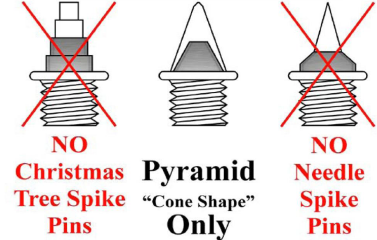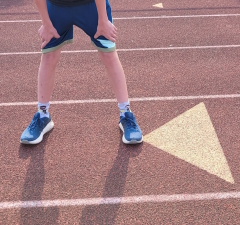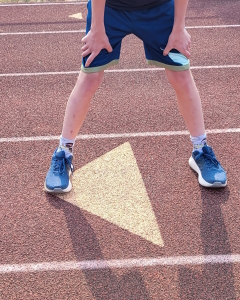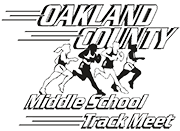Coach and Athlete Guide
A guide to help you and your athletes have a successful experience at a large invitational.
Below are a variety of tips and suggestions to help your athletes have a successful experience. Most of your athletes have only experienced a dual meet or maybe a slightly larger all school district meet. With a large invitational (50+ schools and 1,200+ athletes) there are additional "track awareness" and other rules your athletes may not have been practicing.
Entering and Exiting the Infield
All athletes enter and exit the infield using the one entrance gate. Please do not jump fences. This is to prevent accidental interference and a possible disqualification due to interfering with an ongoing race. Please make sure your athletes understand they must choose safe times to cross the track.
Infield
At a dual meet, we all camp and hang out on the infield. For an invitational, the infield is only for athletes checking in to be clerked for a race or the clerk is walking them to the start line or you are bringing an athlete to the trainer. There is no room for athletes to hang out on the infield. The clerks need the space on the infield to line up the multi heats of each race. Stay off the infield unless going to your event. Athletes (and coaches) should not be running back and forth between the visitor and home stretch. Clerks are trying to get the athletes of the next race to where they need to be. Coaches, please stay inside the coach area on the visitor side of the infield.
Electronic Devices
There are NO electronic devices allowed on the infield. Athletes will not hear the crossing guards yelling at them to not cross because they have their ear buds in and end up crossing in front of a race. They also miss the clerks calling for them to report for checking in. If they miss checking in they miss their race.
Spikes
Athletes may use only pyramid spikes that are 1/4 inch (7mm) or shorter. No pin/needle/Christmas tree spikes will be allowed on the track.

Warming Up
Once the track is closed for racing, all warm ups are to be completed outside of the track. There is a grassy area just outside the back admission gate. The last meet of the year is not the time to be doing 30 handoffs across the infield.
Checking in - Clerking - Heats
For dual meets we are used to showing up at any time near the start line and jumping into whatever heat or lane. Sometimes their might be an adult helper somewhat arranging them. For invitationals, everyone is assigned a certain heat and a lane in that heat. Sometimes the athletes will try to ask another athlete to switch places with them. This is a big no no. With online results which include DRAFT heat sheets, sometimes athletes will assume they know where they should be and do not pay attention to the clerks. Those online heat sheets are DRAFT status. The clerks will often make changes due to scratches, no shows, etc.
Athletes first listen for the calls over the stadium sound system.
- First call is their notice to gather what they need (spikes for example) and begin to make their way to the bullpen area. If they realize they need to use the restroom, they will want to quickly jog to the restroom and then get to the bullpen area to wait their turn for checking in.
- Second call over the stadium sound system is their warning they should already be at the bullpen because the clerk is beginning to check in athletes.
- Third call is for that high jumper to know to check out of high jump and find their "stand in" teammate who is holding their spot for them. The clerk is ready to walk the heats to the start line. Note: If you have a high jumper also in a running event, you want them to have a teammate who will go check in for them at the bullpen. In order for the high jump to actually finish, all the high jumpers need to stay at high jump until third call.
In the bullpen area, a clerk will use a bullhorn to announce to the athletes waiting there what event is ready to check in. Our clerks do their best to announce multiple times. It is the responsibility of the athlete to listen. The clerk will then walk the athletes to a clerking area. There the clerk will line up the athletes into heats and lanes. Once completed, the clerk then walks all the heats to the starting area and hands them off to a start line clerk or for the 4x100 and 4x200 direct them to their exchange zones. The start line clerk or exchange zone umpire will call out when a heat is their turn to race.
Hip Numbers
For distance races (800,1600,3200) every athlete will receive a hip number sticker when they check in with the clerk. The sticker goes on the upper left chest and another sticker (with the same number) will go on the outer LEFT hip so the finish line camera can see their number. The upper left chest number also helps with identifying the runners.
For the 4x400 and 4x800 relays, only the LAST athlete (leg 4) will receive a hip and chest sticker number. They also receive those stickers at the bullpen when they check in with the clerk.
After the athletes finish, as they walk off the track they are instructed to take off the stickers and throw them away. The numbers are for ONE race only. If an athlete is in multiple distance races, they always get a new identifying number.
Distance Race Waterfall Starts and Infractions
For the distance races (800,1600,3200) and the 4x800, the athletes are lined up in two waterfalls. One waterfall is the upper waterfall in lanes 5,6,7 and 8. This is located about 13 meters in front of the start line.The other waterfall is the lower waterfall which is located right at the start line. This extends from lane 1 out to lane 8. The clerks split up the runners between the two waterfalls. At each waterfall the athletes are lined up with the faster seeds toward the outside (lane 8) and slower seeds toward the inside (lane 1). The philosophy behind that rule is to make it so the faster athletes have the outside and not get boxed in.
The athletes first line up on (at Clarkston) green dots located about 3 meters behind the waterfall line. The starter will say "on your marks", the athletes then step up to the waterfall line (but feet behind the line) and stay still, the starter then starts the race. Athletes in the upper waterfall can only cut in to lane 5. They stay in lane 5 to 8 until after the cut in cones right after the first turn. AFTER they pass the cut in cones, they can then cut in to lane 1. The athletes lined up on the lower waterfall can cut in at any time to lane 1.
Help your athletes with learning how/when to cut in. The athletes on the outside (toward lane 8) do not need to immediately cut in to lane 1. In fact if they do, they will most likely be interfering with other runners and potentially be disqualified. On your track, stand with your athletes at various spots on the waterfall start line and show how they might start and begin their race based on where their start location is.
There are two common infractions causing an athlete to be disqualified in a distance race. First one is repeatedly stepping on the inside of the track (lane 1). If an umpire notices you taking 3 or more steps in a row on or inside the line, they will shout out a warning. If the athlete continues to do so, they are disqualified. The other common infraction is cutting in too early after the start of the race as mentioned above. Make sure you run PAST the cut in cones before you go to lane 1.
Sprint Relay Exchanges (4x100 and 4x200)
This is another one of those at a dual meet it is rarely if ever an issue. When you have a full heat of 8 lanes of relay runners, the runners need to make sure they stay in their lanes not just during the race but even after they hand off. A common mistake is after a runner hands off, they immediately walk to the infield. This is not a big deal in lane 1 but in lane 7 you are going to interfere with other athletes trying to exchange. This interference will result in a disqualification. All runners hand off in their lane and then stay standing in their lane after the hand off. The umpire in the exchange zone will let the runners know when it is safe to leave the track.
Example of staying in your lane after a handoff until the umpire dismisses you.
Distance Relay Exchanges (4x400 and 4x800)
The 4x400 is similar to dual meets with a team in each lane (8 total teams at a time). Where 4x400 runners need to be careful is the same as the sprint exchange. After you hand off do not immediately head toward the infield unless you are handing off with no other teams around you. Make sure there is not a team handing off right behind you. Maintain your lane to stay out of the way and then exit the track. Normally not a concern with only 8 teams.
It does become a concern in the 4x800 when you have 16 to 20 teams in a heat. You might have 5 or 6 runners approaching the exchange at the same time. After you hand off you can't just stop on the track and walk off. Complete your handoff, look around and behind you (still jogging) and then exit when you have space so you are not cutting off another runner. The 4x800 exchange is one to have your runners practice. Have a group of 4 or 5 start at the 70ish meter mark. Then run together toward the exchange. Have the runners at the finish line practice lining up at the exchange zone with the coach directing who should be in lane 1 (their runner is coming in first) and next etc. Practice having the coach move runners around to adjust their spot like a finish line umpire would do based on which runners are nearing the exchange zone first. At about the 30 meter mark the outgoing runners stay where they are even if their incoming teammate passes someone. Have the outgoing runner practice putting their hand up or some other signal so the incoming runner can find their teammate and aim for them. This might mean leaving lane 1 and angling out to lane 2,3 or 4. Then after the exchange the incoming runner practice looking around and behind them before exiting to the infield.
Exchange Zone (All Relays)
Besides the occasional disqualification for exchanging outside the zone, another common disqualification is the outgoing runner starting outside the zone.
Some of you still have the old exchange zone markings for the sprint relays. A little triangle marking an acceleration zone (10 meters long for sprint relays) and then the two big triangles marking the start and end of the actual exchange zone (20 meters long). The new exchange zone for sprint relays is just two big triangles (30 meters long total). Where the old small triangle is located is now the new location of the beginning of the 30 meter zone marking the start of the zone. The 2nd big triangle marking the end of the zone is still the same. The sprint relays can start and exchange anywhere WITHIN that 30 meter zone.
WITHIN is the key word. For all relays (sprint and distance), the outgoing runner must start WITHIN the zone. Many middle school runners like to start by standing right on top of the triangle. This is where disqualifications tend to occur. The anxious runner starts bouncing around and steps OUTSIDE the triangle when they start their run. This results in a disqualification. The outgoing runner must stay INSIDE the edge of the triangles at all times. You may want to adjust where you have your runners stand so they do not step outside the edge of the triangle. They can live dangerously and stand on top of the triangle but they need to make sure their foot is not located anywhere on the edge or outside the triangle.
|
Good Example 
|
Disqualification  |
Disqualification 
|
